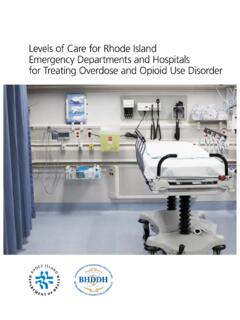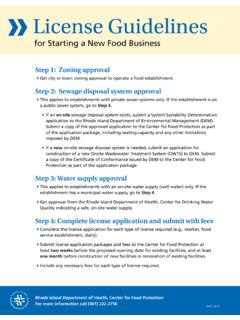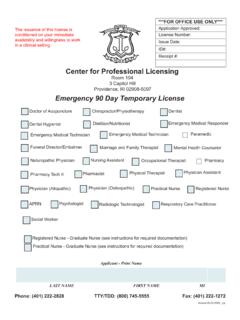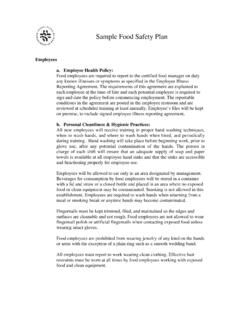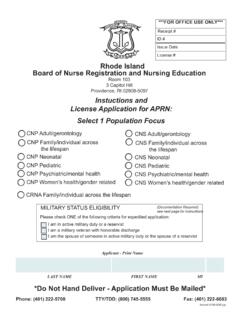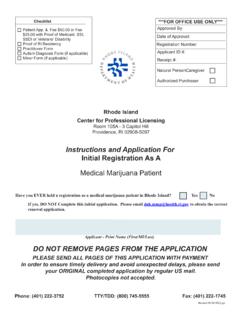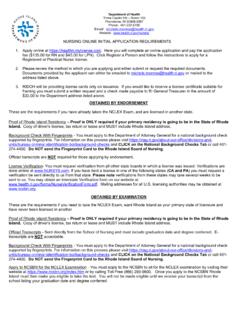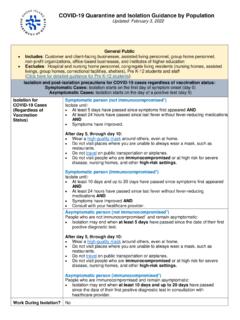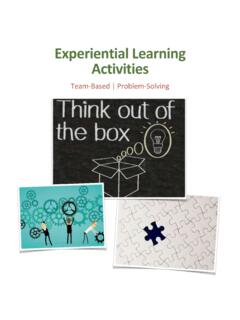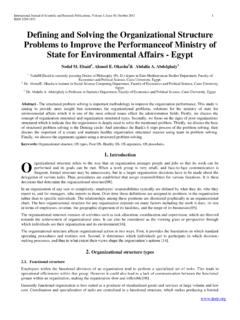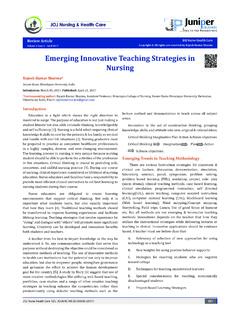Transcription of Master List of Evidence-Based and Innovative Interventions ...
1 M aster List of Evidence-Based and Innovative In terventions for Drug Overdose Prevention November 2019 Master List of Evidence-Based and Innovative Interventions for Drug Overdose Prevention | Rhode Island Department of Health | November 2019 1 Table of Contents Master Evidence-Based Table Term Complementary Master List of Evidence-Based and Innovative Interventions for Drug Overdose Prevention | Rhode Island Department of Health | November 2019 2 Introduction The increasing number of drug overdose deaths has created a public health crisis in Rhode Island. Rhode Island s overdose crisis has impacted every community in the state.
2 The Rhode Island Department of Health (RIDOH) Drug Overdose Prevention Program (DOPP), in collaboration with the Rhode Island Department of Behavioral Healthcare, Developmental Disabilities, and Hospitals (BHDDH), offers this collection of Evidence-Based and Innovative drug overdose prevention Interventions to guide the development and enhancement of opioid-related work. The purpose of this document is to provide communities with the tools and instructions needed to implement drug overdose prevention Interventions with even greater success. This collection of Evidence-Based and Innovative drug overdose prevention Interventions is expected to expand in the future as more research is published on addressing the epidemic.
3 Grantees and partners are urged to consider replicating or adapting one or more of these Interventions to meet the diverse needs of communities across Rhode Island. Disclaimer: Due to federal funding restrictions, funding may not be available for some or all aspects of certain Interventions . For example, grants from the Centers for Disease Control and Prevention (CDC) do not allow for the procurement of medical services or treatment supplies. Check with your grant project officer regarding grant restrictions prior to implementing any initiative. Methodology The following approaches summarize Interventions represented in detail within the Master Evidence-Based Table. RIDOH Approach RIDOH s DOPP used these sources to search for Evidence-Based Interventions : 1.
4 Evidence-Based Practices Resource Center; 2. Substance Abuse Mental Health Services Administration (SAMHSA): Preventing Prescription Drug Misuse: Programs and Strategies; 3. Association for Territorial and Health Officials (ASTHO) Primary Prevention Science-Based Approaches; 4. Blueprints for Healthy Youth Development; 5. Centers for Disease Control and Prevention Overdose Data to Action Notice of Funding Opportunity; 6. Published research articles; and 7. Information provided by Subject Matter Experts (SMEs). Evidence-Based Interventions were selected based on a review of scientific literature and consultancy with content experts. The Interventions demonstrated four qualifying criteria: 1) Valid and reliable research design; 2) Evidence that has influenced the target population(s); 3) Availability of evaluation tools, or the ability to design and implement an evaluation tool within a limited timeframe; and 4) Alignment with one of the four strategic pillars of Governor Gina M.
5 Raimondo s Overdose Prevention Action Plan (Prevention, Rescue, Treatment, and Recovery). Master List of Evidence-Based and Innovative Interventions for Drug Overdose Prevention | Rhode Island Department of Health | November 2019 3 In addition to Evidence-Based Interventions , RIDOH s DOPP selected several promising innovations that have shown an experiential success. Many of these promising innovations are already embedded in the State of Rhode Island s opioid overdose prevention activities . BHDDH Approach BHDDH reviewed and used these sources to search for Evidence-Based Interventions : 1) SAMHSA: Center for the Application of Prevention Technologies (CAPT) Decision Support Tools Preventing Prescription Drug Misuse: Overview of Factors and Strategies, May 2016; 2) SAMHSA: CAPT Preventing Heroin Use; Facts, Factors, and Strategies Issues Brief; 3) SAMHSA: Preventing Prescription Drug Misuse: Programs and Strategies; and 4) SAMHSA: Registry of Effective Practices and Programs (since discontinued).
6 The identified strategies fit into two categories programs or Interventions based on research that could feasibly be implemented at the state level and complementary activities that can be coupled with another program or intervention. Authors Linda Barovier, MS Dahianna Lopez, PhD, MP H, MS N Contributors RIDOH BHDDH EOHHS Annemarie Beardsworth, CCPH Elizabeth Farrar Catherine Cool Rumsey Lauren Conkey, MPH Olivia King, ScM Gina Deluca Candace Rodgers, MPH, CHES Rachael Elmaleh Christina Hom, MPH Jennifer Koziol, MPH Meghan McCormick, MPH Mia Patriarca, MA Master List of Evidence-Based and Innovative Interventions for Drug Overdose Prevention | Rhode Island Department of Health | November 2019 4 M aster Evidence-Based Table T erm Definitions Identifier Interventions numbered for ease of reference Pillar Prevention, Rescue, Treatment.
7 Or Recovery The program or intervention was identified as meeting one of the four strategies of Governor Gina M. Raimondo s Overdose Prevention Action Plan. Intervention Name of intervention Each program or intervention was identified as addressing one or more of four opioid-related issues: drug use, opioid use, overdose, or addiction. Description Program or intervention description, including intended outcomes (underlined) and intended target populations Evidence Brief description of some general outcomes that were found in the literature Peer-Reviewed Research Yes or no; identified peer-reviewed research that was conducted on the program or intervention Considerations General notes that may be of interest to anyone considering implementing the named intervention.
8 Master List of Evidence-Based and Innovative Interventions for Drug Overdose Prevention | Rhode Island Department of Health | November 2019 5 Prevention Prevention Interventions can be defined as primary, secondary, or tertiary. Below are definitions for each level of prevention from Kolodny et al. (2015).1 The aim of primary prevention is to reduce the incidence of a disease or a condition. Opioid addiction is typically chronic, difficult to treat, and associated with high rates of morbidity and mortality. Thus, bringing the opioid addiction epidemic under control requires effort to prevent new cases from developing. The aim of secondary prevention is to screen for a health condition after its onset, but before it causes serious complications.
9 Efforts to identify and treat opioid-addicted individuals early in the course of the disease are likely to reduce the risk of overdose, psychosocial deterioration, transition to injectable opioid use, and medical complications. Tertiary prevention strategies involve both therapeutic and rehabilitative measures once a disease is firmly established. The goal of tertiary prevention of opioid addiction is to prevent overdose deaths, medical complications, psychosocial deterioration, transition to injectable opioid drug use, and injection-related infectious diseases. Doing so is accomplished mainly by ensuring that opioid-addicted individuals can access effective and affordable opioid addiction treatment. Identifier Pillar Intervention Description Evidence Peer- Reviewed Research Considerations PRIMARY PREVENTION Prevention Brazelton Touchpoints Home Visiting Training drug use Brazelton Touchpoints training builds the capacity of early childhood professionals to support the expertise of families to provide sensitive, nurturing, and developmentally informed caregiving.
10 2 The program focuses on the intersection between a child s biology, environment, and relationships with caregivers. Brazelton refers to periods of developmental regression followed by bursts as touchpoints because they provide opportunities for providers working with families to touch into the family Providers trained in this method can better support resiliency and family Evaluation of home visits based on the Touchpoints model is associated with better maternal-infant interaction, increased well-child care treatment adherence, improved child developmental outcomes, enhanced maternal mental health indicators, more prolonged breastfeeding, and greater satisfaction with care by providers six months postpartum4.
